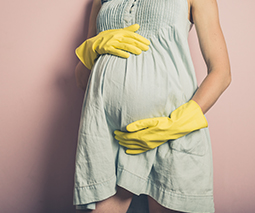Everything you always wanted to know about your waters breaking

When movies involve a pregnant woman it’s all about her waters breaking. A hilarious or dramatic moment where she thinks she’s peed her pants, but no, it’s actually the baby coming. Like most stuff on the screen, it’s usually not like the real thing at all.
Here’s a rundown of how the whole water breaking process REALLY goes.
What are your ‘waters’, actually?
During pregnancy, your baby lies inside the womb in a membranous sac filled with amniotic fluid, which helps to create more room for the baby to grow by pushing on the uterine wall and acts as a cushion to protect baby from things such as a fall. The fluid also helps your baby learn how to breathe and swallow and helps prevent infections.
When and why your waters usually break
Typically, a pregnant woman’s waters break when she’s full term and at the start of labour, or sometimes during labour – also known as spontaneous rupture of membranes (SROM). It happens due to the enzymes, proteins and other factors in the membranes being activated from labour: stress on the membranes from contractions, and the membranes being weakened (particularly near your cervix) as your baby grows to full term.
Breaking early
In some cases, a woman’s waters may break at full term before she’s in true active labour which is known as premature rupture of membranes (PROM). This can be caused by a variety of things, such as having a large baby, pre-labour pains (Braxton Hicks), too much fluid in the sac, and infections such as in the bladder or kidney. It can also happen when a woman is preterm (before 37 weeks, also known as preterm premature rupture of membranes – PPROM) which is much more concerning and will usually lead to a premature delivery.
What happens when your waters break?
It’s different for a lot of women but many experience some mild cramping or pain first, and then a ‘pop’ sensation with a literal gush of clear or pale yellow water from their vagina (like they’ve peed their pants). Others will only feel a trickle of fluid down below which may continue throughout labour, or it might actually be an amniotic leak instead. As most waters don’t break until the mother is in full-blown labour, many women may not have any idea that it has actually happened if they are concentrating on contractions or pushing.
Broken, now what?
Once your waters break, it usually means you’re going into labour (if you’re not already), so if you think it has happened, call your doctor immediately, especially if you’re preterm or were planning to have a c-section, to determine whether it’s the real deal, a leak or a false alarm. If your sac membranes have indeed broken, unlike in the movies, birth won’t necessarily happen in a matter of hours. In some cases, the baby might not appear for seven days, but either way, delivery is inevitable. If you’re preterm, your doctor may also take methods to delay the birth to help your baby grow more, but infection is a risk to both mother and baby, so this will depend on mum and bub’s overall health at the time.
Do all waters break?
Interestingly, no! While it’s very rare, amazingly some babies are born ‘en caul’, where they pop out still entirely cushioned inside the amniotic sac and no membranes have broken. Check out these 11 incredible photos of beautiful babies born in their birth sac.
Manual break
If you’re in active labour and your waters haven’t yet broken, your doctor may also decide to manually break it by inserting their fingers vaginally and pushing on the membranes. This is also known as artificial rupture of the membranes (AROM) and is often performed to speed your labour along, particularly if you’ve been induced. While it can be painful for some, at least you’ll know for sure that your waters have broken and you’ll already be at the hospital!








